Rochester’s Railroads
Not long after the arrival of the Erie Canal and Rochester’s initial boom, the railroad arrived. Rochester’s first local “railroad” was not a railroad in the traditional sense, but a road into which rails had been laid. Built by the Rochester Canal and Railway Company in 1832, this rail road allowed carriages equipped with railway wheels to be pulled by a team of horses along a three mile stretch of land between Rochester and Carthage, a former village located at Lower Falls. The rail road only operated until 1839 as it was deemed unprofitable.
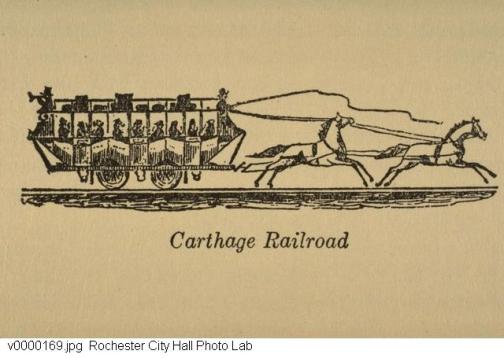
Despite this shaky start, there was still a need in the quickly growing Western New York region (for the purposes of this history, the area west of Syracuse) for year-round transportation of both goods and people, something that was not provided by a canal that was not operational through the winter. This need was answered in 1837 with the arrival of Rochester’s first steam-powered locomotive. Delivered to the city via the Erie Canal, this locomotive was used by the Tonawanda Railroad Line between Rochester and Batavia.
What followed was a rapid boom in Rochester’s railroad industry. In 1841 the Auburn and Rochester Railroad introduced lines that connected Rochester to Canandaigua, Geneva, and Auburn. By 1842 new amenities were introduced on passenger lines including separate lavatories for men and women. Rochester was added to the state-wide rail lines in 1844 when lines from the east and west connected the city to Buffalo and Albany, and in 1850 a railroad line was laid from Rochester to the village of Charlotte to allow commercial traffic to enter the Great Lakes system.
By this point, Rochester had ten separate independent railroad lines. However, they were consolidated to form the New York Central Railroad and by 1853 all lines running through Rochester were owned by New York Central. In 1854, in response to this monopoly, the Rochester and Genesee Valley Railroad was created. The Rochester and Genesee Valley Railroad created a route that ran south of the city and connected Rochester to the Erie Railroad. That same year, in an effort to maintain control of the Rochester area, New York Central built Rochester’s first passenger station between Mill and State Streets.
Passenger trains through Rochester were on par with those elsewhere in the country and provided the most up to date amenities for travelers. In 1858, sleeper cars were introduced. The following year, smoking cars started to appear, and in 1860, dining cars began providing passengers with meals on their journeys.
The Civil War contributed to the rapid growth of Rochester’s railroad industry. In the 1860s, traffic and tonnage traveling along the railroads quadrupled and this spike in demand caused the city to add spur lines and sidings to the existing lines. There was also a boom in available jobs related to the industry. The second half of the nineteenth century saw the population of Rochester quickly increase due to the increase in job opportunities and by 1890, the population had reached 133,896 people.
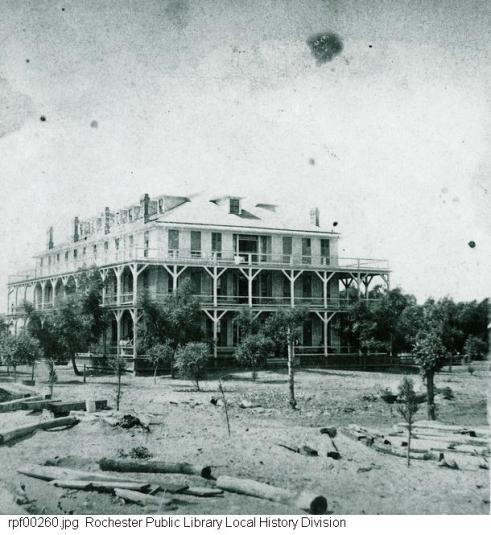
Not only did the growth in job opportunities lead to an increase in population, but it also led to an increase in the disposable income of those living in Rochester, money which could be spent on leisure activities. This created a need for further passenger railroad lines that could transport people to beach resorts such as Sea Breeze and Ontario Beach. Several lines developed in the 1870s for just this purpose. The Lake Ontario Shore Railroad brought its passengers from the city to resorts, such as the Spencer House and Allen House hotels and beaches on Lake Ontario. Similarly, the Rochester and Glen Haven Railroad took passengers the three and a half miles from East Main Street to the Glen Haven Resort on the Irondequoit Bay, while the Rome, Watertown & Ogdensburg Railroad took passengers from Rochester into the north country, advertising “pleasure trips” between June and October.
Meanwhile, other parts of Rochester’s railroad industry continued to grow. Although the New York Central and Hudson River Railroad, now controlled by the Vanderbilt family, was still the dominant railroad company in Rochester, others began to crop up around the city. The Erie Railroad continued to operate as a passenger line out of their Exchange Street Station. The Lake Shore and Michigan Southern Railroad, which advertised drawing room cars and “Palace” sleeping cars for its passengers, connected Rochester to the Midwest (Ohio and beyond). The Rochester Stateline Railroad, built in response to the city’s growth, was created to ship coal in from Pennsylvania and to bring passengers down to the Southern Tier.
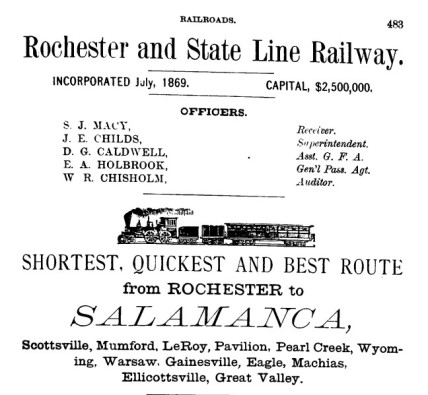
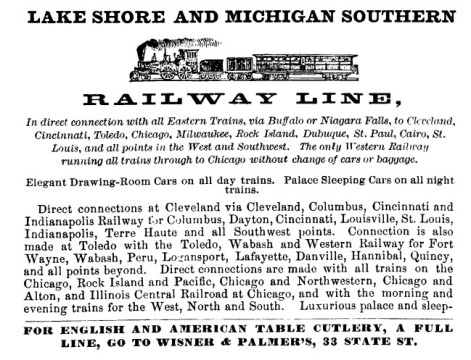
Although many new lines developed in this period, not all of them were successful. Some, like the Rochester & Pine Creek Railroad which was created in 1870 and gone by 1871, simply disappeared. Others were bought out by larger lines. Some lines were even created with the intent that they be leased out to other, larger lines. The Avon, Geneseo and Mt. Morris Railroad, for instance, was leased in perpetuity to the New York Central and Hudson Railroad. This cycle of creation and failure or consolidation continued through the end of the century. By 1890, Rochester had as many as a dozen different railroad lines operating within the city, but by the turn of the century, this had been reduced to just five. These were the New York Central Railroad, the Erie Railroad, the Pennsylvania Railroad, the Buffalo, Rochester & Pittsburgh Railroad, and the Lehigh Valley Railroad, which arrived in Rochester in 1892.
These ever-expanding railroad companies required the construction of support structures throughout the city. In 1872 a new roundhouse was built on Atlantic Avenue followed two years later by new switching and freight yards on Goodman Street, the demand having outgrown the Brown Street switching yard. By 1883 the New York Central and Hudson Railroad outgrew their Mill Street passenger station and a new one was built on Central Avenue at North St. Paul Street. The Western New York & Pennsylvania Railroad also built a new station at the former Peter Pitkin house at 81 West Avenue, now West Main Street. A new passenger station was also built by the Buffalo, Rochester & Pittsburgh Railroad at 62 West Avenue (modern-day West Main Street), though it has since been repurposed as Nick Tahou’s Hots.
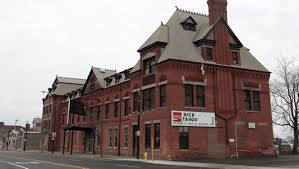
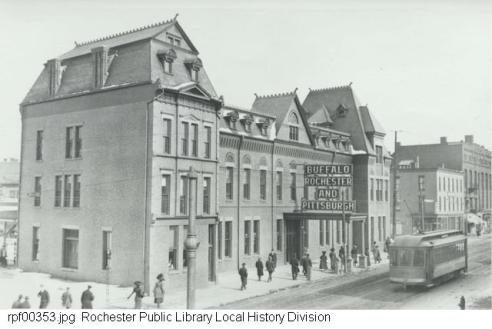
By the early twentieth century, Rochester had become a hub of railroad activity, serving as the gateway between New York City and the American Interior for passengers and freight. By 1911, as many as 700 freight cars were being scheduled out of Rochester daily. In addition to an increase in volume, the Rochester also saw an increase in the regularity, efficiency, and dependability of its railroad. The increase in activity saw another flurry of construction to service the still growing industry.
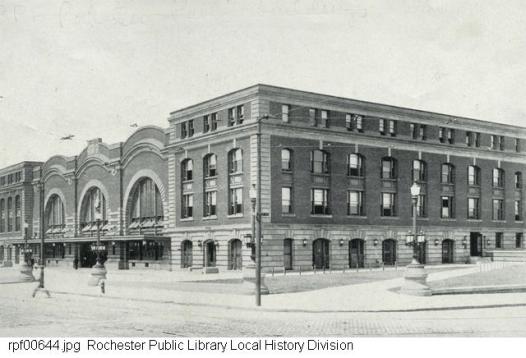
In 1905, a swing bridge over the Genesee River at Charlotte was constructed to carry the West Shore Railroad and the Rome, Watertown & Ogden Railroad across the river. This bridge was used as a river crossing until 1995, when it sat unused until it’s removal in 2012 after being deemed a hazard to river navigation. In 1907 two new stations were built. The first was built on the Genesee River over the old Seymour and Johnson mill race for the Lehigh Valley Railroad. Like the Buffalo, Rochester & Pittsburgh Railroad station at 62 West Avenue, this too was repurposed as a restaurant and now stands as Dinosaur Bar-B-Que. George Eastman built the second of the 1907 railroads, called the Kodak Park Railroad. In 1913, the New York Central Railroad again outgrew its station and a third was built. This new station, located on Central Avenue between North Clinton Avenue and Joseph Avenue, was designed by a local architect named Claude Bragdon. This project cost the company $2 million, but it served them well, as the large brick and brownstone station continued to function as Rochester’s primary railroad station for over 40 years. It was in this period that Rochester had its largest number of railroad stations, listed and depicted below. These stations included those built for interurban lines, trolleys that carried passengers between Rochester and neighboring towns and cities. These lines, operating between 1900 and 1910, were the Rochester & Syracuse line, the Rochester, Lockport & Buffalo line, the Rochester & Eastern line, and the Rochester & Sodus Bay line.

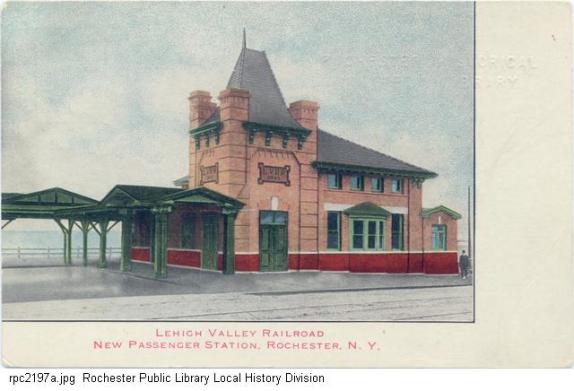
Map of Rochester’s rail stations on the Plat Map from 1910.
Unfortunately, the early twentieth century also saw the decline of the railroad in Rochester. Although they continued to be used for mail, passengers, and commercial transport, the advent of World War One and the rising popularity of the automobile in the 1920s led to a decline in general railroad usage. This included the interurbans, as they were becoming unpopular on the streets now being dominated by cars. This was further exacerbated by the Great Depression in the 1930s, which led to mergers and closures of major rail lines through the city. In 1930, the Baltimore & Ohio Railroad bought the Buffalo, Rochester & Ohio line, and in 1935 the New York Central Railroad ended their passenger service on the Hojack Line.
Further closures came in the middle of the century with the continuing rise of the popularity of personal automobiles. Investors turned to backing the creation of roads and highways in favor of railroads. The 1950s saw the popularity of the New York State Thruway in particular rise, which replaced trains as the dominant mode of travel through the state. This, along with the completion of the Eastern Expressway in 1961, which connected Rochester to the Thruway, and the Inner Loop around the city in 1965 was the death knell for railroads in Rochester. The Lehigh Valley Railroad ended their Rochester service in 1950 followed quickly by the Baltimore & Ohio Railroad in 1953.
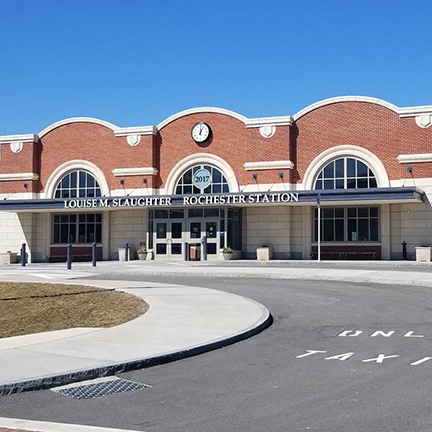
The rise of the aviation industry further accelerated the decline of the railroad. Smaller lines continued to fold or be consolidated into larger, more successful railroads. In 1968, the New York Central Railroad and the Pennsylvania Railroads consolidated to become the Penn Central Railroad. This railroad then merged with the Lehigh and Erie Lackawanna Railroads to form Conrail in 1976. Under-used lines were removed and right-of-ways were sold. Many old railroad beds were repurposed as hiking trails and walkways and most of Rochester’s railroad stations were razed to make way for other construction. The only station that was still in operation was the Bragdon station on Central Avenue. This building was razed in the mid 1960s to make way for a newer station and today the Louise M. Slaughter Amtrak Station is the only passenger station that operates in Rochester. Today, the use of railroads is a fraction of what it once was, though Amtrak carries passengers daily and freight continues to move through Rochester on CSX rails.